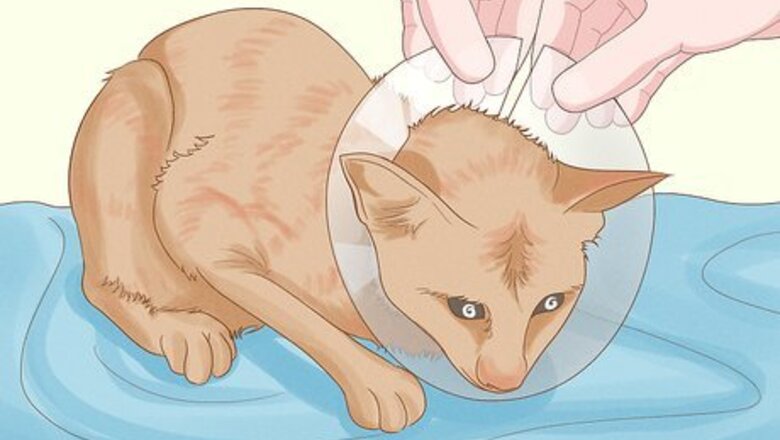
views
- Dab a pea-sized amount of dish soap on the oily spots and massage their fur gently.[1]
- Try to keep the dish soap out of its mouth, eyes, and ears, as this can be irritating to your cat.
- Note: small amounts of olive oil are not toxic for your cat.
Bathing Your Cat
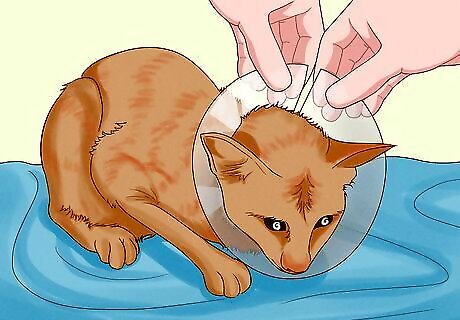
Keep your cat from licking the oil by putting a cone around its head. It may hate this, but you must stop it from ingesting the oil. If you need help, have someone else hold your cat while you secure the cone around its neck. If you don’t have one, you can purchase a small cone from a pet supply store to keep on hand for moments like these; or, you may be able to get one for free from your vet’s office.
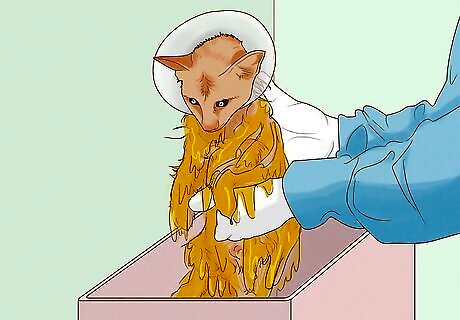
Change your clothes and put on gloves to protect yourself from the oil. Depending on the situation and how much oil is on your cat, it may be impossible to keep the oil from getting on your hands and clothes, too, so put on things you don’t mind getting dirty. Once you realize that your cat has oil on it, you need to move as fast as possible to get yourself changed and ready to bathe it. The longer the oil is on your cat, the greater the risk that it could negatively affect it.
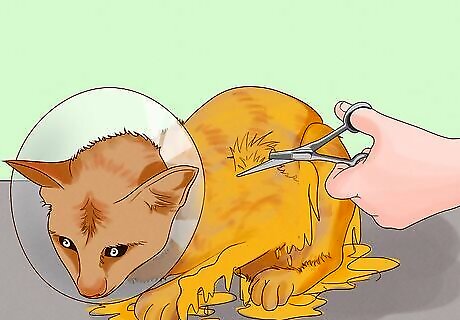
Use scissors to carefully trim away dried oil-based paint from your cat’s fur. Already-dry sections should be removed first before you wash your cat. Do your best to hold your cat very still while you do this so that it doesn’t get scratched. You may want to gently pull the painted section of fur away from your cat’s body and trim it that way. If the paint is on your cat’s skin, don’t shave it or try to trim super close to its body. Instead, wash those areas with warm, soapy water to prevent any accidental cuts or scratches. Most other oils your cat might get into, like essential oils, gasoline, or cooking oils, won’t harden on its fur.
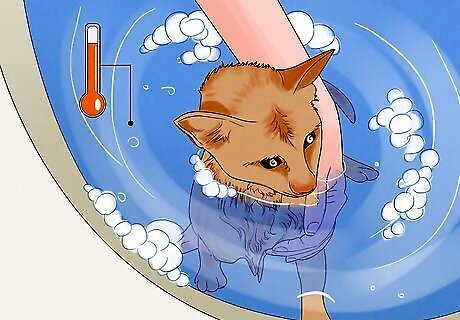
Wash your cat with warm water and mild dish soap. Dish soap will cut through the oil much more thoroughly than regular cat shampoo. Use either the sink or bathtub to wash your cat, whichever feels easier for you to keep a hold on it during the process. Get its fur wet with warm water, then rub a small pea-sized amount of mild dish soap into the oily sections. Massage the fur to remove the oil. If the oil is around your cat’s face, use a cotton ball to apply warm, soapy water to the fur and skin. Do your best to keep water and soap out of its eyes, ears, and mouth. If there is oil on its paws, don’t neglect the spaces between its toes. Use a cotton ball or cotton swab if necessary.

Rinse your cat with warm water until all the suds are gone. Use a plastic cup or something similar to gently pour warm water over the soapy areas until the water runs clear. If you use a spray hose, just make sure the spray is gentle and that the water doesn’t get too hot. If you notice there are still patches of oil, apply more dish soap and wash your cat a second time.

Dry off your cat with a soft towel and keep it warm for the next hour. Cats have so much fur, it can be difficult to get them dry. Gently pat your cat’s fur to remove as much excess water as possible, then wrap it in a big towel. Put it somewhere warm, like near a heating vent or in a sunny room, so it can get dry and warm. If your cat is agreeable, you could try to dry its fur with a blowdryer. Just make sure the dryer is on the lowest heat setting. Avoid rubbing your cat's fur—it most likely will not enjoy that and the sensation could be uncomfortable for it.
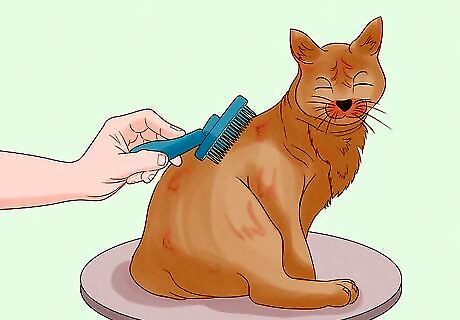
Take your cat to a groomer or the vet if it won’t let you bathe it. Some cats just refuse to be bathed and there’s nothing you can do about it. Instead of stressing or trying to force a bath (which could potentially injure both you and your cat), pack it up in a carrier and get it to a groomer or the vet. Call ahead and let them know you have an emergency so they’re ready for you. Your vet’s office is well-equipped to bathe a cat. You’ll need to pay for the visit, but you’d have to pay a groomer, too. Whichever option is closest, least expensive, or available is the best one to pick.
Taking Your Cat to the Vet
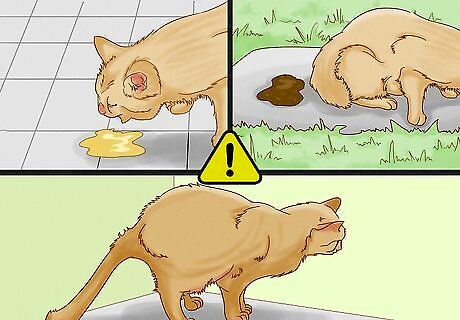
Seek veterinary care if your cat seems to be in distress. Oil-based paints, essential oils, gasoline, and other oils can cause skin irritation as well as internal discomfort. Most cats will recover just fine from an encounter with oil, but some might need some extra care from a vet. If you notice these symptoms, call your vet or just take your cat straight there for a checkup: Vomiting Diarrhea Trouble walking or standing Lethargy Difficulty breathing Tremors or shaking
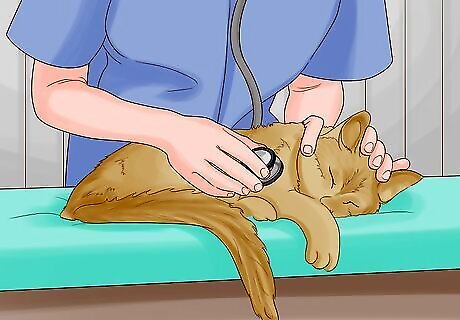
Take your cat to the vet if you suspect it swallowed oil. Never try to induce vomiting—vomiting could introduce oil to your cat’s esophagus and lungs, which could cause more severe problems. If there’s a chance your cat was licking oil of its fur before you got to it, be safe and make a trip to the vet to get it checked out. If your cat vomits on its own, there’s no way to stop that. Just keep an eye on things and take your cat to the vet if it’s having trouble breathing or develops other abnormal symptoms.
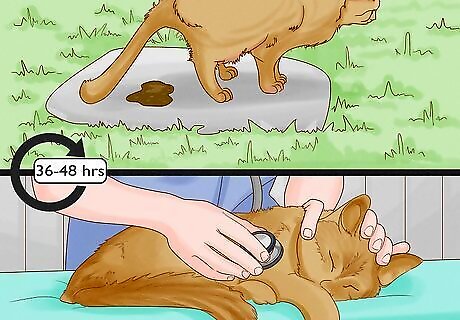
Visit the vet if your cat develops symptoms after several days. Even if your cat seems to be acting like normal at first, it could still get sick within the few days after being exposed to oil, especially if it swallowed any. For 36-48 hours, watch for vomiting, diarrhea, shaking, lethargy, and respiratory problems. It’s better to be safe than sorry. If your cat is acting abnormally and has recently been exposed to oil, even if the oil just got on its fur, a visit to the vet is in its best interests.
Keeping Your Cat Safe from Oils
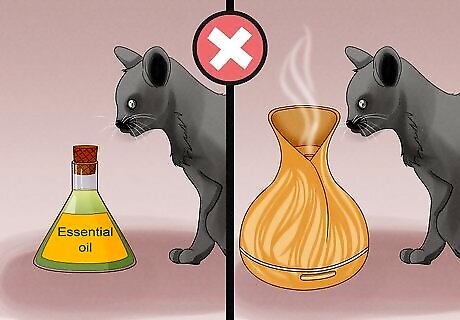
Keep diffusers and essential oils stored out of the way. Cats love to knock things over, and diffusers and bottles of essential oils are no exception. Keep them somewhere your cat can’t get to them or in a room it doesn’t have access to. If your cat gets essential oils on its paws or skin, the oil could irritate and possible burn its skin. If you notice that your cat is unsteady on its feet, extremely cold, or more lethargic than usual, take it to the vet. If your cat ingested essential oils, it may also have vomiting or diarrhea. Take it to the vet if you notice these symptoms.
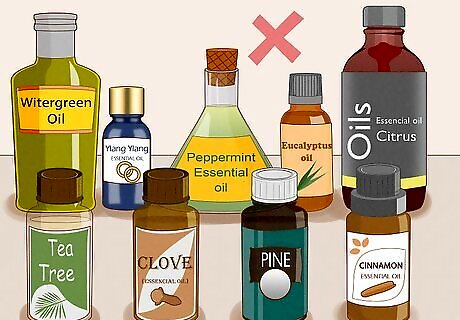
Avoid using certain essential oils in your home if you have a cat. Essential oils can be absorbed through your cat’s skin if it comes into contact with it, and its liver lacks a certain enzyme that helps flush the toxins out. If the oil is just in the air, your cat should be fine; though, there could be some respiratory irritation if the scents are particularly strong. The following oils have had negative effects on cats: Wintergreen Pine Citrus Ylang Ylang Peppermint Cinnamon Clove Eucalyptus Tea tree
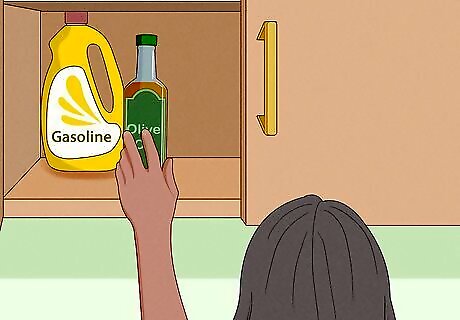
Put away oils when you’re done using them so your cat can’t get into them. Oil-based paints, gasoline, cooking oils, and other kinds of oil should never be left out in the open. Put the lid back on the container whenever possible, and store the oil in a safe place, like in a closet or pantry. If you’re in the middle of a project and don’t want to put your supplies away, then make sure your cat can’t get into the room where the oil is located.
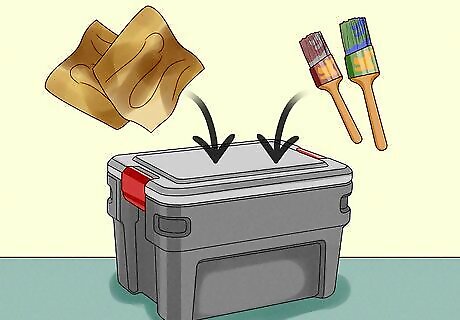
Put trash, rags, and other oily materials into a lidded container. Paper towels, used paintbrushes, dirty rags, and other items that were used should be either thrown out or put away somewhere they can’t easily be accessed. If you throw things away in a trash can, make sure the lid fits tightly on the container so your cat can’t knock it off. Even things like drop-cloths shouldn’t be left out if there is paint or oil on them. Fold them, roll them, or close off the space they’re in to keep your cat safe.
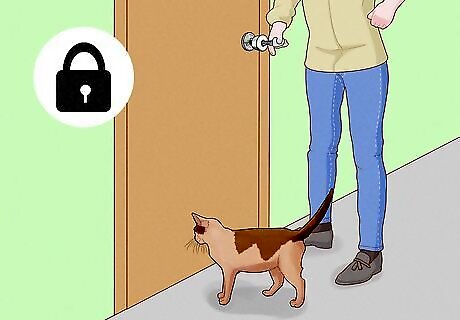
Block off any rooms or areas that have exposed oils in them. This can be hard with cats—they seem to want to go everywhere, especially those rooms where you don’t want them! But if you’re working on a project in the garage or home, you need to keep your cat safe. Close doors, put up gates, or try taping a plastic cloth over the entryway to discourage your cat from going inside. You may need to keep your cat out while you’re working, too. It’s bound to want to explore what you’re doing, so take care to keep it away so it doesn’t get exposed to any oils.


















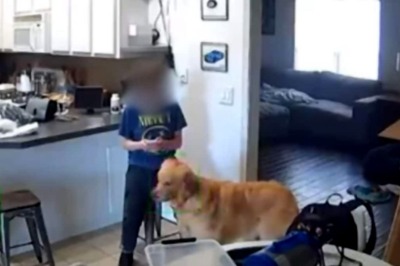
Comments
0 comment